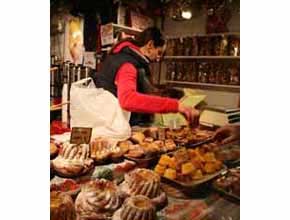Articles
11 January 2008
Christmas in Alsace
Its history, its landscape, its culture and its traditions make this area a very attractive tourist destination, especially during Christmas where all the traditional” Marchés de Nöel” are displayed. Weihnachten (Christmas or literally " holy night ") gets ready from the beginning of December with the Advent calendars, trees decorated with balls, festoons and dolls and the crown of the Advent.
Alsace is French but you feel in Germany when you wandered along the little villages of this endearingly folkloric province on the Rhine. And this is because this is a region strongly marked in its history and its culture by its geographical situation. Stronghold of the kingdom of Germany as of 9th century, throughout history Alsace's borders switched back and forth many times between French and German territory , until World War II when it finally returned to France, but even today, Germany is present all over.
GOOD FOOD
Foddies will be happy in Alsace because of the superb gastronomy of this land of good eating, good living.
From winstubs to star-rated restaurants, and not forgetting the region's farm-inns, an impressive range of establishments welcome visitors and Alsatians alike to enjoy authentic regional dishes.
Sauertkraut
The emblematic dish of the Alsatian kitchen is the Sauerkraut or Choucroute. It is composed of sliced and cooked cabbage, sausages and meat, and can be prepared in many ways, in particular "Garnie", "Royale" or "de la Mer”.. In the olden days, Alsatian families used to make their own sauerkraut, fermenting it in wooden barrels. Its high vitamin C content and easy preparation made it a popular dish: you simply grate white cabbage and put it in sealed containers. The cabbage is fermented with salt, with no water or additives, apart from seasonings. It can be served after 3 weeks of fermentation, and it keeps for several months. It can be eaten in many ways: in quiches, with fish, pickled, with Riesling poured over it, and more.
Other traditional dishes are the Baeckeoffe (a dish composed of 3 kinds of meat, potatoes and white wine) and the Riesling Cock (coq au Riesling). Lots of river fish, like carp or perch, and delicious dishes with wild game (pheasant, partridge or deer) are also very tasty.
Flammekuche
In the 18th and 19th centuries, the tarte flambée was made in the Kochersberg region for the lunchtime meal. This rectangle of bread dough, topped with cream, onions and bacon, is very popular today. But for a long time, this Alsatian dish was not well known, because it was only made by people who had bread ovens. In the olden days, the first flames that burned when the oven was started up were used for making the tart. This is where the name “flame tart” comes from, becoming “tarte flambée” in French. It is like a very thin pizza, alsatian style.
Munster cheese
Around the VIIth century, monks Benedictines melt a monastery dedicated to Saint-Grégoire in the current valley of Munster. Confronted with the problem of the conservation of milk and the need for nourishing the neighbourhood, the monks invented "Munster Kaes", the cheese of Munster such as we know it today. Also known under the name of Munster-Gérémomé, of the name of the city where its marketing was carried out, Munster is classified AOC since 1969 and manufactured on the Alsatian and Lorraine faces of the Vosges.
This delicious cheese is manufactured with curdled milk. Once salted, this soft cheese is put in cellar for a refining which lasts 21 days at least. Universally known for its savour, Munster is consumed natural, without bread, accompanied by a powerful red wine Gewurztraminer, Pinot Noir or an Alsatian Beer.
Foie gras
Alsatian foie gras owes its reputation to the foie gras pâté created in 1778 by Jean Pierre Clause, the cook of Marshal Contades, who was the military governor of Strasbourg at that time. . The court of Louis XVI, quickly allured by this delicatessen, will quickly popularize it in all the kingdom.
The Goose Foie gras, with fine and delicate savour, has the favours of the gourmets of the whole world. There are several names which depend all on the type of selected manufacture. The cooked Foie gras are three: whole Foie gras, Foie gras made up exclusively of pieces of lobes and Blocks of Foie gras containing reconstituted Foie gras and of a certain percentage of pieces.
Foie gras can either be served in a terrine, or hot, in different ways: one of the most popular recipes is foie gras steak, fried with potatoes, or Hot Goose Liver with Grapes and Reinette Apples.
At the beginning of meal, better serve it between 2 and 4° to appreciate all its smoothness together with late grape harvest or liqueur-like wines such Jurançon. Excel with Tokay or Pinot Gris, it's also extremely good with the great vintages of Bordeaux like Saint-Estèphe wine or Saint-Emilion...
Pork butchery
"Gendarmes", "Knacks", ham and other sausages are a real treat for meat lovers ... Famous Choucroute would be nothing if it did not marry so well with all that "cochonaille" Alsatian has of better. You will regale yourselves sausage slice of bread or beef sausages (true knack) of liver (leberwurst). As for sausages, choose them with pistachio or black (schwarzwurst), with blood (blutwurst) or ham (schinkenwurst), or giants, with great pieces of language (zungenwurst) taken in a black "farce". There add all the galantines, fume pork-butcheries (pallet, schieffele, bacon, gendarmes, net of pig...), without forgetting the round of the heads, where throne the famous presskopf ("pressed head"), star of the winstubs, tasted out of vinaigrette and you will have a rather complete outline of what is the true Alsatian Pork-butchery.
Kugelhopf
Dusted with a snowfall of confectioners' sugar (preferably just when purchased or before being served), kugelhopf is said to go with everything at any time of day. Its soothingly neutral flavour, with an even balance of sweet and salt, is as good with morning coffee as with afternoon tea, evening wine or a midnight beer or, at any hour, with a shot of icy clear eau de vie like kirsch, mirabelle or framboise. It seems particularly right at this season, for holiday brunches or between-meal snacking. This famous cake’s name means “risen ball”. Legend has it that the recipe for this brioche and the shape of the mould were given to a potter of Ribeauvillé by the name of Kugel, by the Three Kings, whom he welcomed with hospitality. In honour of that event, a Fete de Kugelhopf is held every June in Ribeauville. It must also be noted that the word ''kugel,'' in German, means a sphere or a ball, which might also have something to do with the name. At any rate, the current shape of the Kugelhopf (a circular, bulging mould with ribs that make it easy to share out into portions) is rather recent.
Throughout Alsace, souvenir and kitchenware shops display every size and colour of kugelhopf mould, the most basic being the plain earthy brown and the fanciest having richly colored glazes and hand-painted flowers or other kitschy decorations. It. is much closer to bread than to cake, made with yeast, flour, very little sugar and salt, small amounts of butter and a few eggs. You will enjoy it with a Gewurztraminer or a Cremant d’Alsace.
One classic variation, however, is the savory kugelhopf, enriched with bits of smoky bacon and crunchy walnuts, which is meant to be served with aperitifs.
Bretzels
Some say that bretzels, which are truly emblematic of traditional Alsatian baking, were invented by a baker from Ingwiller. Some say that this baker, who was much loved by the villagers, had a weakness that landed him in prison: swearing repeatedly against the lord. In exchange for his freedom, the lord asked him to invent a cake in which he would be able to see the shape of the sun three times. And thus the bretzel was born. Another explanation attributes the shape of the bretzel to very ancient sun worship: according to this theory, bretzels originally consisted of a cross with a ring around it. In any case, this crunchy biscuit, made from dough poached in water, is very popular.
Pastry for Chritmas
Christstollen is the traditional cake of Christmas, with candied fruits, raisins, spices, rum, almond paste and covered with icing sugar. The shape of this cake, which dates the Middle Ages, is supposed to represent the Christ baby in its diapers.
Traditional Spekulatius ( spéculos ), Lebkuchen ( gingerbread), Zimtsterne (stars in the cinnamon), Vanillekiperl (vanillés crescent moons) or Marzipankartoffeln (potatoes marzipan) are made throughout December. Cinnamon, anise, cardamom, clove or vanilla flavours covered with icing sugar to décor trees and feed our kinder stomachs.
ALSATIAN WINES
One interesting way to discover the area and its gastronomy is along the Vineyard trail, crossing vineyards and charming villages
Alsace is gifted with rich soil, perfect for cultivating vineyards responsible for the production and export of some famous white wines such as Gewurztraminer, Riesling or Tokay. A glass of Gewurztraminer is the perfect complement to Munster Cheese.
"A small glass of Alsace wine is like a summer dress or a spring flower; it's a ray of sunshine that makes life brighter," said Christian Dior. Alsace is the only region of France to continue the tradition of making varietal wines only Alsatian wines bear the name of the grape varieties used to produce them. There is only one type of red wine (Pinot Noir) as white wine is by far the most common:
Sylvaner: this is a light, fresh wine with a discreet, fruity taste. It goes well with fish, seafood and cold meat.
Pinot Blanc: well-balanced and often fruity, this wine offers slight acidity combined with aromas of violet or iris. This versatile wine accompanies most dishes well.
Klevener de Heiligenstein: sometimes considered as the ancestor of the Gewurztraminer, only spicier. This wine is round, with a light flavour. It is ideal as an aperitif and with dessert.
Muscat: this dry wine offers peppery sensations, combined with powerful aromas of fresh grapes and fruit. It can be served as an aperitif and is perfect with asparagus, too.
Riesling: a dry white wine with character, Riesling offers aromas of citrus fruit, sometimes accompanied by mineral or floral notes. It is perfect with sauerkraut, poultry and fish.
Pinot Gris: this is a full-bodied, round and well-balanced wine. Moderately acidic, it offers aromas of undergrowth and yellow fruit. It goes perfectly with foie gras, poultry and wild game.
Gewurztraminer: very appreciated for the richness of its bouquet, this wine is intense and full-bodied. It develops aromas of honey or exotic fruit, and goes very well with dessert, cheese and exotic cooking. It is excellent as an aperitif, as well.
Pinot Noir: this variety can be used to produce two different wines: Rosé Pinot Noir and Red Pinot Noir. Rosé Pinot Noir is light, supple and acidic. It evokes flavours of red berries. Red Pinot Noir offers aromas of cherry or smoke. Both widic. It evokes flavours of red berries. Red Pinot Noir offers aromas of cherry or smoke. Both widic. It evokes flavours of red berries. Red Pinot Noir offers aromas of cherry or smoke. Both wines may be served with red meat, strong cheese or cold meat.
For everything you ever needeines may be served with red meat, strong cheese or cold meat.
For everything you ever needed to know about wine in Alsace, please contact the
Comité Interprofessionnel des Vins d'Alsace :
http://www.vinsalsace.com
BEVERAGES
Other beverages like beer (best known breweries: Adelshoffen, Fischer, Heineken, Karlsbräu, Kronenbourg and Météor) or schnapps offered like digestives are very popular too. Mirabelle and quetsche plums are the most common types. These are dry, but generally very fruity spirits. And don’t forget the Gluehwein or Traditional Mulled Wine.
Alsace also deserves something especial for the non-alcoholic visitors, ancient mineral water of great quality like Wattwiller, one of thouse waters with pedigree: written record was first made by the Romans during their occupation of the area of Gaul now known as Alsace
Do you need some more reasons to visit Alsace?
Laura Gosalbo
January 2008
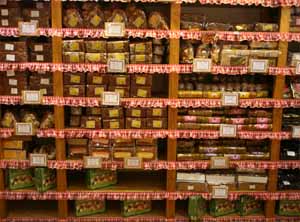
Assorted Pain d'Epice in one Alsatian deli shop.
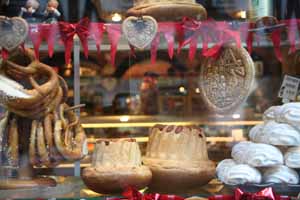
Delicious Kugelhopf
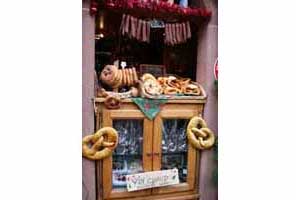
Bretzels and hot wine
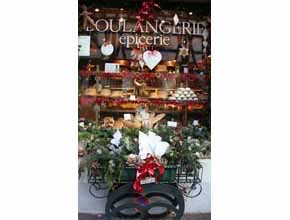
Bakery in Hunawir
